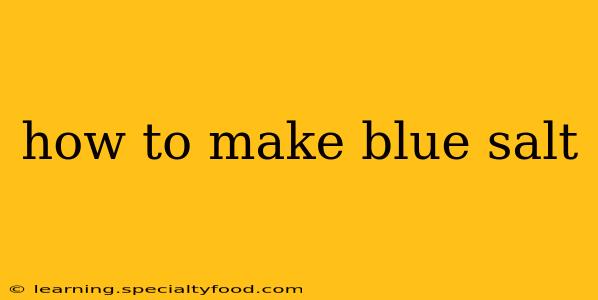How to Make Blue Salt: A Guide to Creating Stunning, Naturally Colored Salts
Blue salt isn't a naturally occurring mineral like pink Himalayan salt or sea salt. Its vibrant blue hue is achieved through the addition of food-safe colorants. This guide explores various methods for making blue salt at home, emphasizing safety and achieving visually appealing results.
What Makes Blue Salt Blue?
The blue color in blue salt is typically derived from food-grade coloring. While some sources claim natural minerals can create blue hues, these are rare and generally not used for culinary purposes. Common food-safe colorants include:
- Blue spirulina powder: A natural, nutrient-rich algae powder that imparts a deep blue color. It also adds a subtle earthy flavor.
- Butterfly pea flower powder: Another natural option, offering a vibrant blue color that can change to purple depending on the pH of the salt.
- Blue food coloring (gel or liquid): Widely available, these artificial colorants provide an intense blue color. Always ensure it’s specifically designed for food use.
It's crucial to use food-grade colorants to ensure the safety and edibility of your blue salt.
How to Make Blue Salt Using Different Methods:
Here are three methods for making your blue salt, catering to different levels of effort and desired intensity:
Method 1: The Simple Mix-and-Match Method (Best for beginners):
This method is ideal for a quick and easy approach using fine salt and a powdered colorant.
- Gather your ingredients: Fine sea salt or kosher salt (coarse salt requires more mixing), and your chosen food-grade blue colorant (spirulina, butterfly pea flower, or food coloring).
- Prepare your salt: Ensure the salt is completely dry. Any moisture can affect the color's intensity and distribution.
- Mix the colorant: Start by adding a small amount of the colorant to the salt and mix thoroughly. Gradually add more until you achieve the desired shade of blue. It’s better to start with less and add more than to add too much at once.
- Let it dry (optional): If you used a liquid colorant, let the mixture air dry for a few hours to ensure the salt is completely dry and the color has set.
Method 2: The Layered Look (More advanced, visually stunning):
This method provides a more visually interesting result, mimicking the natural stratification seen in some minerals.
- Prepare layers: Divide your salt into small batches. Add different amounts of colorant to each batch to create variations in the shade of blue.
- Layer the salt: Carefully layer the colored salt in a jar or container. Start with the darkest shade at the bottom and gradually work your way up to lighter shades.
- Compact the layers: Gently press down on each layer to help it settle and create a distinct separation between colors.
Method 3: The Infused Method (for stronger, even color):
This is the most labor-intensive method but gives a more intense and even color. This is better with liquid colorants.
- Prepare a solution: Dissolve the food coloring in a small amount of water or alcohol (such as vodka).
- Combine with salt: Gradually add the dry salt to the coloring solution, stirring gently to ensure the salt is evenly coated.
- Dry the salt: Spread the moistened salt on a baking sheet lined with parchment paper. Ensure the salt is spread thinly to allow for even drying.
- Dry thoroughly: Allow the salt to air dry completely or dry in a low oven (around 200°F/93°C) for a few hours, stirring occasionally.
Safety Precautions:
- Use food-grade colorants only. Non-food-grade colorants are toxic and should never be used in food preparation.
- Handle the colorants carefully. Avoid inhaling the powder and wear gloves if you have sensitive skin.
- Store your blue salt in an airtight container to maintain its color and prevent moisture absorption.
Frequently Asked Questions (FAQs)
How long does homemade blue salt last? Properly stored in an airtight container, your homemade blue salt can last for several months.
Can I use blue salt in cooking? Yes, you can use it to add a visual pop to your dishes. Remember that the flavor will be impacted by the colorant used. Spirulina and butterfly pea flower will add subtle flavors, while artificial food coloring will have little to no impact on flavor.
Can I use blue salt in a bath? While generally safe for skin, it is always best to test a small amount first for any allergic reactions.
Creating your blue salt allows for personalization and creative expression. Experiment with different colorants and methods to achieve the perfect shade and aesthetic for your culinary or decorative needs. Remember to prioritize safety and use only food-grade materials.
